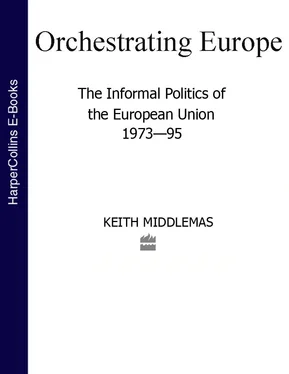The outcome owed something to cooperation within the ‘Troika’, as Luxembourg eased the agenda from drafts to final texts with few votes but always ‘noting where the majority lay’; But the primary momentum came from the fact that all twelve governments wished to see the internal market come to fruition. Some participants concluded that the British alternative scheme’s intention had come about and that in this area the national veto had already died. 50Ireland’s assent (postponed for two years for legal reasons, to meet the Irish courts’ insistence and followed by a referendum) was actually taken for granted by the Belgian Presidency in 1986, as if QMV already existed.
Five IGC meetings sufficed to bring the documents to two Council meetings in December 1985. Divisions and alliances between states varied according to the issue being debated. Real disagreement however centred on four main questions: which single market decisions were to be taken by QMV? How far should cohesion extend, and in what form? How should cooperation and co-decision with the Parliament operate in foreign affairs? What place should be given to EMU?
None of these was susceptible to a simple solution and the wider implications of each ran on to Maastricht and beyond. The text on EMU divided France, Belgium, Italy and Ireland, all of which thought it too weak, from Germany and the Netherlands which wanted the relevant articles attached to but not incorporated as an integral part of the Treaty. Britain did not want either, or indeed any reference to EMU, certainly not before the internal market’s complete freedom of capital movements had been achieved.
The arguments had no empirical basis, except in current practice in running the EMS and ERM, Britain not being a member of the latter. But the eventual compromise rested on promises from France and Italy to liberalize their exchange control provisions – promises which were turned into a guarantee of abolition before the single market deadline came, at an ECOFIN meeting in June 1988, just prior to the Hannover Summit. Meanwhile, the preamble of the SEA was given three indents referring to the ‘objective of EMU’, together with a chapter stating that the member states should cooperate to ensure the convergence of economic and monetary policies.
On this somewhat ambiguous basis, EMU was to be included in the pre-Maastricht process. The Single European Act retained majority voting for all EMS decisions, so that Britain could still exercise a veto, even though it was not in the ERM. Nevertheless, two years later at Hannover, the UK government did concede that the Central Bank Governors Committee, chaired by Delors, might examine ways of setting up the future European central bank, and the ‘concrete steps’ towards EMU long sought by France.
An increase in structural funds (coherence policy) to appease Ireland’s and Greece’s fears about the impact on their economies, eased the Act’s passage, up to its ratification by nine governments in February 1986, and by Ireland more than a year later. Some member states seem not to have realized how large these sums would be, when measured afterwards in relation to Iberian needs. It also brought a trade-off between the German federal government and the Länder (led by the Bavarian and North Rhine Westphalia prime ministers, Franz-Josef Strauss and Johannes Rau, which gave the Länder increased rights of participation in decision-making in Bonn). These were to be a foretaste of the regional compromises made at Maastricht in 1991. Success in the IGC negotiations, reform of the CAP, and extension of QMV to financial services’ liberalization, satisfied British ambitions. The Italians got their extra powers for the Parliament, 51the Netherlands and Belgium achieved an extension of political cooperation, Germany a clearer definition of regional policy, and France its hopes of EMU. From all this stemmed the mood of euphoria leading on to Maastricht.
But that was only the legal framework: much space remained for Commission interpretation. Officials’ creativity during the next six years improved on what had actually been agreed, while members transposed what eventually became the 285 legislative enactments, in order to meet Cockfield’s deadline of 1st January 1993. Among the twelve governments, opinions inevitably varied. (Margaret Thatcher particularly resented the way the Commission used Articles 100 and 235 to obtain ECJ confirmation of its interpretation. 52) It was not clear until the Hannover Summit in June 1988 that all the heads of government had ‘irreversibly accepted’ the SEA: indeed the Act deliberately had not made the 1 January 1993 deadline a legal obligation, so that the internal market would not be final until all its provisions had been transposed and implemented. Whereas transposition had nearly been completed by the 1st January 1993, implementation still fell far short.
At the time of Hannover, 194 out of 285 legislative items remained to be completed. But the breakthrough on exchange control abolition had come. The legislative programme no longer depended on each six months’ Presidency (which was as well, since the Greek government attempted to turn the proceedings after Hannover in the direction of social policy, training and worker consultation, which would inevitably have aroused industrialists to make a renewed ‘Vredeling offensive’. 53) Member states’ mid–term failures to transpose legislation were already being remedied by an informal system of mediation, réunions paquets (see below, p. 628). Great as the delays were to be, even beyond 1992, the main technical problem after Hannover lay not with visible barriers but the implicit ones, created out of ‘exceptions’ through which member states continued to defend their chasses gardées long after they had conceded the former. Although Hannover represented a political landmark, ‘beneath its calm surface, the battle between liberals and interventionists for control of the 1992 project was at last launched.’ 54
In the two and a half years after the IGC, the game between states, Commission and industrial players continued, 55complicated by the entry of new players from Spain (which played a part in the second Banking Directive). Most of the advantage, however, accrued to the Commission, which did not seek to hide its wider design but only to nuance it for different audiences as the next stage – harmonization of VAT, excise and corporation tax – approached. 56The Commission concentrated, for example, on reducing national restraints on air transport and the carriage of goods, and on the agreement over car imports with Japan. Officials accepted that some implementations would be delayed beyond 1 January 1993, particularly by Mediterranean countries (especially those concerning Spain’s financial services and Italy’s state industries), but relied on the states’ commitments, sealed at Hannover, to limit delays to an acceptable level.
Having been very largely excluded during the bargaining process from Milan to Luxembourg, the Parliament also increased its part during later stages of the single market negotiations, as Cockfield steered his enactments through. Some 260 legislative items remained after the Act’s second reading, together with a host of amendments, and in the process MEPs acquired a power through practice which they were later to consolidate at Maastricht. This extended informally to areas where MEPs had no direct competence at all. 57
The financial sector also emerged as a player, now that EMU’s shadow lay over the internal market. Banks and insurance companies, at least in the northern states, joined the various action groups and some even took part in public campaigns for 1992 through their domestic press and television. Huge financial gains were being made in these sectors by 1988, much greater than Cecchini had forecast; more in France and Germany than in Britain, but most of all in Italy and Spain, where the least open markets operated. 58Harmonization affected all securities markets and stock exchanges, and Spain went through its own ‘big bang’ in 1989–90, as London had done eight years earlier. Nothing was invulnerable to foreign access, not even long-closed insurance and mortgage finance sectors.
Читать дальше









![Brian Thompson - A Monkey Among Crocodiles - The Life, Loves and Lawsuits of Mrs Georgina Weldon – a disastrous Victorian [Text only]](/books/704922/brian-thompson-a-monkey-among-crocodiles-the-life-thumb.webp)


